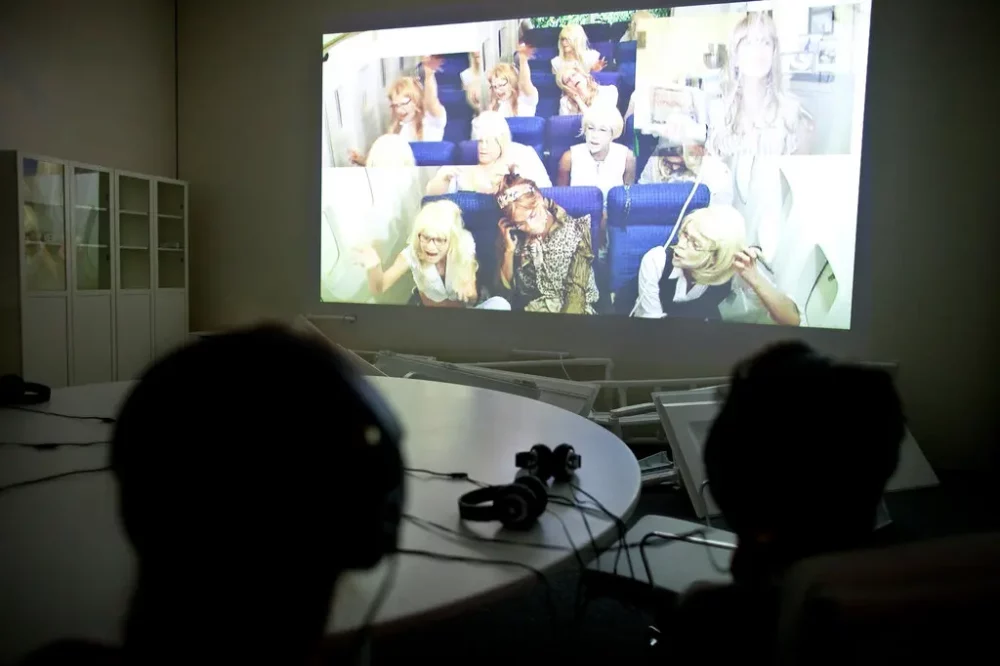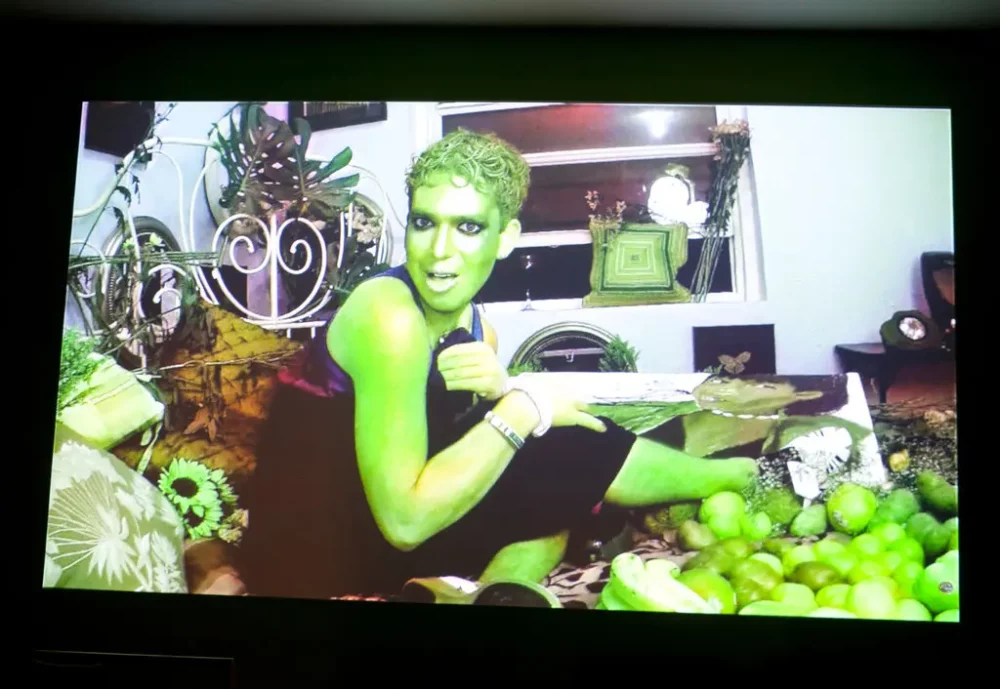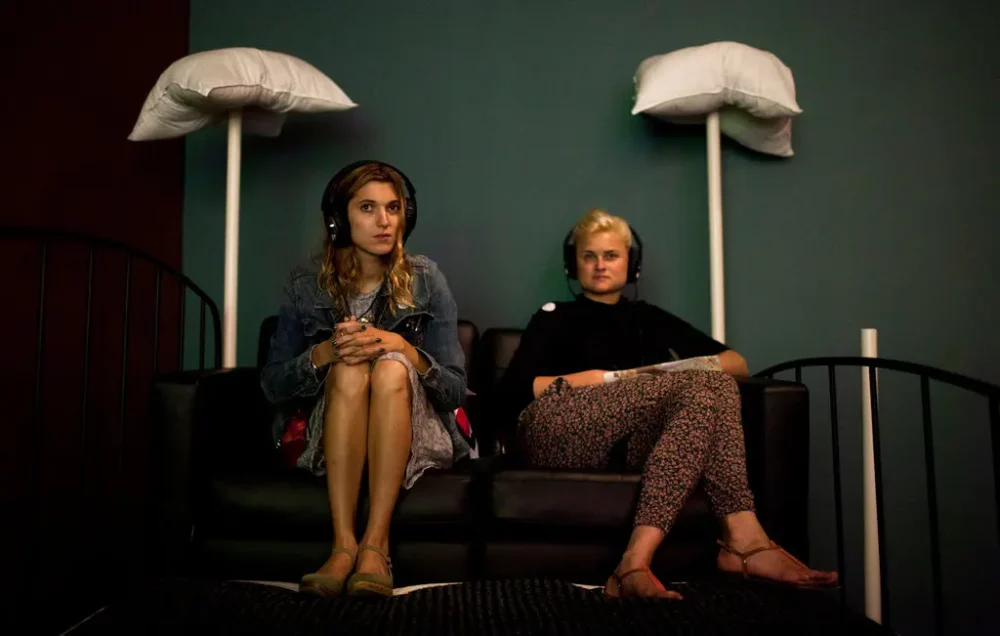
- Source: THE NEW YORK TIMES
- Author: Roberta Smith
- Date: June 23, 2011
- Format: PRINT AND DIGITAL
Like Living, Only More So

Ryan Trecartin's show at MoMA PS1 creates distinctly designed environments filled with furniture and other elements meant to complement a particular video. This room features the video “K-CoreaINC.K (section a). Ty Cacek/The New York Times
“Am I overexisting or am I over existing? That’s my inside joke.” These words — evoking a doubt-free Hamlet unfazed about whether or not to be — bounce forth from the tumult of video, furniture, music, extreme makeup and insistent jabberwocky that form “Any Ever,” Ryan Trecartin’s game-changing exhibition at MoMA PS1 in Long Island City, Queens.
The question is posed on screen by Mr. Trecartin himself, in the role of Wait, one of several video personas he assumes to interact with an extended supporting cast of young, energetic cross-dressers; eccentrics; globally ambitious hobbyists; friendly freaks; and the odd child or household pet. Their wild, sometimes incoherent exchanges teeter giddily at the intersection of art, reality television and social networking, and unfurl across seven related, frenetically edited videos made during the last two years. Keep an eye out especially for Telfar Clemens, the magnetic group leader in drag; Veronica Gelbaum, a riveting young Norma Desmond type; and Lizzie Fitch, the free-floating pundit who is also Mr. Trecartin’s chief collaborator on all fronts.

A scene from the video “Ready (RE'Search Wait'S),” part of Ryan Trecartin's show “Any Ever” at MoMA PS1, with Mr. Trecartin in one of his video personas. Ty Cacek/The New York Times
In these videos characters screech and squeal, debate and argue in high-pitched Chipmunkese or bottom-feeding growls; scenes jump-cut back and forth; makeup is a form of painting in its own right. Images (and characters) multiply, split and mutate. Gender, identity and skin tone are nothing if not fluid, and plotlines are aggressively nonlinear. Corporate game plans and family ties entangle, often with great intensity of feeling. Tweets and text messages blink on the screen, and spoken language seems on the verge of reinvention. People break things, jump into pools, make paintings, tip over sculpture. And it doesn’t stop there.
At PS1 each video is projected large in its own insane room, carpeted throughout and densely arrayed with couches, yard furniture, airplane seats, gym equipment or conference tables and all sorts of other stuff stacked around the edges. Nothing is as it should be, strictly speaking. One room features six couches whose feet are planted in cheap-looking designer-purse knockoffs. In another, couches are placed on bed frames stacked on bookcases and reached by plastic ladders. As with the work of artists like Paul McCarthy, Matthew Barney and Pipilotti Rist — only more so — these situations effectively break the grip of the black-box video theater and forge a new integration of video and installation art.
Mr. Trecartin (pronounced tra-KAR-tun), who is 30 and made his New York gallery debut in 2007, is definitely overexisting. His PS1 spectacular is his first major museum show in New York; it reveals an immense but not fully developed talent that seems bound for greatness. At the risk of oversimplification, his art could be said to combine the retinal extravagance of much 1980s art with the political awareness of the ’90s and the inclusiveness and technological savvy of the postmillennium. This exhibition shreds the false dichotomies and mutually demonizing oppositions that have plagued the art world for decades — between the political and the aesthetic, the conceptual and the formal, high and low, art and entertainment, outsider and insider, irony and sincerity, gay and straight. Queerness here is not a cause; it is a constant condition that has now permeated the culture at large.

The room installation where Ryan Trecartin's video “Ready (RE'Search Wait'S),” is shown, with museum visitors listening to the video's soundtrack on headphones. Ty Cacek/The New York Times
Mr. Trecartin was born in Texas and grew up in Ohio, and by his own account was not much exposed to art as a child. In interviews he has cited Disney and the disco music his babysitters listened to as important influences. Like many children, he enjoyed the age-old games of dressing up and putting on plays with friends; but, growing up in a time when cameras were becoming ubiquitous and also digital, he began to photograph these stagings when he was in sixth grade.
Shortly thereafter, a photography teacher showed him images of Cindy Sherman’s work. Her influence is evident in the groups of blond-wigged Sherman-like creatures (men and women) who swarm through several videos, especially one titled “K-CoreaINC.K (section a),” in which, overseen by Mr. Clemens, they clamorously fill several rows of airline seats.
Mr. Trecartin entered the Rhode Island School of Design in 2000, soon after Apple introduced its iMovie software, which made it possible to edit video on the computer. Fast-forward to 2005, the year after he graduated, when “A Family Finds Entertainment,” the manic, color-saturated 40-minute video that was Mr. Trecartin’s senior thesis — as well as his way of coming out to his parents — was screened to a wildly enthusiastic audience at the New York Underground Film Festival. It marked the beginning of his rapid rise, both in the art world and on the Internet, where all his work is available. Since then he and Ms. Fitch have become known for video and video-installation presentations that have progressively redefined both genres.
This redefinition is in full cry at PS1, where the controlled chaos of the videos can feel thrillingly continuous with the spaces in which they are viewed. Two of the videos here were seen in funkier environments orchestrated by Mr. Trecartin and Ms. Fitch in “Younger Than Jesus” at the New Museum in 2009. The mises-en-scènes are socially and visually sharper and work better at PS1, where they are composed almost entirely of furnishings from Ikea, as are many of the sets in the videos. In addition to the massed décor there is ambient music, most of it composed by Mr. Trecartin, which oscillates from room to room. Visitors must don large, cushy headsets to get the full gist of the individual videos, a cocooning experience that parallels the physical cocooning of the furnishings. The show is a rabbit hole full of rabbit holes.
Mr. Trecartin seems intent on a kind of sensorial overload that you may initially think only new media can provide. But in many ways the idea of giving viewers more than they can instantaneously absorb is almost as old as art itself and is what keeps us coming back to it. Earlier versions of this overload include the endless detail of Jan van Eyck’s paintings, the collapsing simultaneities of Cubism, Jackson Pollock’s skeins of dripped paint or, to cite more obvious predecessors of Mr. Trecartin’s work, the found-object environments of Edward Kienholz and the gender-bending costume-drama orgies of the filmmaker Jack Smith.
Still, new technology has allowed Mr. Trecartin to articulate and dimensionalize his version of overload more fully. True to his early admiration for Disney, his labor-intensive editing, carefully scripted cross talk (despite all signs of improvisation) and other digital machinations have allowed him to negotiate a blend of animated and actual life never dreamed of by the creators of the film “Who Framed Roger Rabbit” or the virtual world Second Life. In the process he has also brought such disparate elements as language and furniture, music and makeup into active, mutually enhancing play, in which he neglects few opportunities for manipulation. In “Ready (RE’Search Wait’S),” one of the more recent videos, a combination of actual makeup and digital adjustment enables Mr. Trecartin to transform himself effortlessly from Wait, a relatively shy wallflower, to J. J., a bronze-god painter who is surrounded by handmade and mechanical images and cascades of iridescent color.
At the heart of Mr. Trecartin’s elaborate worldview is an aspirational faith in the potential of uninhibited self-expression, both individual and collective, as an active agent against the mounting materialism of everyday life. This is in a sense the story of his own hypertalented overexistence, now aided and abetted by a fluctuating crew of co-conspirators with gifts, charisma and minds of their own. What he has unleashed is larger than himself, which is why both his sudden appearance and continuing evolution are such cause for hope.

